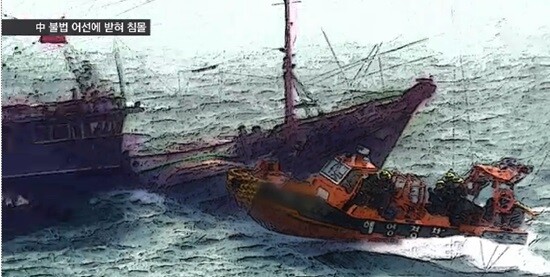hankyoreh
Links to other country sites 다른 나라 사이트 링크
After sinking, S. Korean government authorizes shooting of illegal fishing vessels

The South Korean government plans to allow the firing of guns as needed against illegal fishing boats strongly resisting capture.
The move comes in response to an incident on Oct. 7 in which a Chinese boat engaged in illegal fishing rammed and sank a high-speed Coast Guard vessel in the West (Yellow) Sea. Measures were also developed to pursue boats fleeing into China’s territorial waters and track them into international waters for capture.
The policy for crew-served weapon usage, which is based on the Maritime Policing Act, marks the first time Seoul has announced plans for the weapons’ use in cracking down on illegal fishing by Chinese boats.
The government’s announcement of the stiffer policing measures on illegal Chinese fishing boats came after a countermeasures meeting for related institutions on Oct. 11 at the Central Government Complex in Seoul. The most notable of them was the decision to actively exercise compelling force by using crew-served weapons and striking at hulls with the mother ship as needed when crew members on Chinese boats use violence to prevent the performance of Coast Guard duties. The stern response plans include directly striking at hulls with 20-mm Vulcan and 40-mm cannon fire and using patrol ships to ram Chinese fishing boats that attack Coast Guard patrol vessels.
The current Maritime Policing Act allows the use of crew-served weapons in cases where ships or criminals attack Coast Guard offers with their vessels or dangerous weapons, but the permissions have not been actively invoked to date. In the case of the recent high-speed vessel sinking, the Coast Guard officers only discharged personal weapons such as K-1 rifles and K-5 handguns into the air as a threat.
The government also plans to adopt a new operational approach to Chinese boats that flee to elude capture in South Korean waters by tracking them into international waters for apprehension. The Coast Guard plans to notify its Chinese counterpart during the tracking process and request capture if the vessels enter Chinese waters.
Additional plans involve holding consultations with China on extraditing criminals caught there from the vessel in the recent incident, or providing the necessary evidence for a Chinese trial if extradition is not possible. If the vessels are apprehended in South Korea, the Coast Guard has said it may apply charges of attempted murder for the sinking, in which two Chinese boats rammed a high-speed vessel carrying enforcement personnel. It also explained its reasons for not disclosing video footage of the sinking, arguing that doing so could influence the arrest process if the vessels in question flee, go into hiding, or alter their hulls. The footage may be released once the vessels are apprehended, it added.
By Won Nak-yeon, staff reporter
Please direct questions or comments to [english@hani.co.kr]

Editorial・opinion
![[Editorial] Penalties for airing allegations against Korea’s first lady endanger free press [Editorial] Penalties for airing allegations against Korea’s first lady endanger free press](https://flexible.img.hani.co.kr/flexible/normal/500/300/imgdb/original/2024/0502/1817146398095106.jpg) [Editorial] Penalties for airing allegations against Korea’s first lady endanger free press
[Editorial] Penalties for airing allegations against Korea’s first lady endanger free press![[Editorial] Yoon must halt procurement of SM-3 interceptor missiles [Editorial] Yoon must halt procurement of SM-3 interceptor missiles](https://flexible.img.hani.co.kr/flexible/normal/500/300/imgdb/child/2024/0501/17145495551605_1717145495195344.jpg) [Editorial] Yoon must halt procurement of SM-3 interceptor missiles
[Editorial] Yoon must halt procurement of SM-3 interceptor missiles- [Guest essay] Maybe Korea’s rapid population decline is an opportunity, not a crisis
- [Column] Can Yoon steer diplomacy with Russia, China back on track?
- [Column] Season 2 of special prosecutor probe may be coming to Korea soon
- [Column] Park Geun-hye déjà vu in Yoon Suk-yeol
- [Editorial] New weight of N. Korea’s nuclear threats makes dialogue all the more urgent
- [Guest essay] The real reason Korea’s new right wants to dub Rhee a founding father
- [Column] ‘Choson’: Is it time we start referring to N. Korea in its own terms?
- [Editorial] Japan’s rewriting of history with Korea has gone too far
Most viewed articles
- 160% of young Koreans see no need to have kids after marriage
- 2Months and months of overdue wages are pushing migrant workers in Korea into debt
- 3[Editorial] Penalties for airing allegations against Korea’s first lady endanger free press
- 4Historic court ruling recognizes Korean state culpability for massacre in Vietnam
- 5Presidential office warns of veto in response to opposition passing special counsel probe act
- 6[Guest essay] How Korea must answer for its crimes in Vietnam
- 7Story of massacre victim’s court victory could open minds of Vietnamese to Korea, says documentarian
- 8Historic verdict on Korean culpability for Vietnam War massacres now available in English, Vietnames
- 9Bills for Itaewon crush inquiry, special counsel probe into Marine’s death pass National Assembly
- 10In rejecting statute of limitations defense in massacre case, Korean court faces up to Vietnam War a